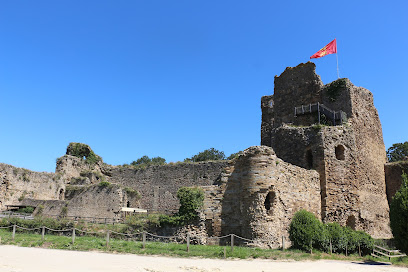Talmont Castle
The fortress of Talmont was founded in the 11th century, when William the Bald was granted a coastal territory marked by Norman invasions. The region was then under the authority of William V, Count of Poitou and Duke of Aquitaine.
Thanks to archaeological research, we can identify the first stone constructions of the castle and date them to 1020.
A strategic location
Guillaume le Chauve, the first lord of Talmont, began building a stone church around 1020, then a bell tower-porch, around which a wooden, then very quickly stone, enclosure took the shape of a rock surrounded by water. Bordered by two rivers, the Sauvagère and the Payré, the site is completely isolated twice a day during high tides. In fact, the sea, now 6km to the south, used to bathe the foot of the château. This proximity enabled Guillaume to use pebbles to build his fortress; as most castles were made of wood, he was able to establish his prestige by erecting stone walls and buildings. His son, William the Younger, continued his work by erecting an imposing keep.
The castle overlooks the Payré estuary and an important port, the largest between Nantes and Bordeaux. The town of Talmont benefited from maritime trade and grew rapidly to the north of the fortress.
Guillaume le Chauve founded the Abbey of Sainte-Croix; large covered market halls housed fairs and markets where wine and salt producers flocked. William the Younger, second lord of Talmont, showcased this dynamism by building a ceremonial hall in the dungeon, offering an unobstructed view of the town through three large windows.
Setting the castle ablaze
The main tower was partly destroyed by a violent fire when Guillaume de Lezay, then Lord of Talmont, revolted against the King of France, who had recently married Eleanor, Duchess of Aquitaine. Even today, heat-reddened stones bear witness to this episode in the castle’s history.
On the death of Guillaume de Lezay, the fortress became the property of the Mauléon family, whose influence grew thanks to advantageous alliances.
Raoul III, attached himself to Richard, Duke of Aquitaine, and was appointed seneschal of Poitou in 1199. On his death, his brother Guillaume inherited his property and continued to consolidate the power of the de Mauléon family.
Savary de Mauléon: An influential lord close to the Plantagenets
Savary de Mauléon, receives the castle of Talmont. A strongman of Poitou, close to Jean sans Terre and appointed seneschal several times, he took on the prestigious title of the first lords of Talmont, becoming Prince (princeps Thaleamundi). The fortress was then transformed into a castle, whose menacing, majestic appearance reflected the power of its owner.
However, the independence and strength of the Mauléon family was undermined as soon as Savary died, by the intervention of the French king, Louis IX, who took possession of the Talmondais region in 1233. French influence grew, and by 1242, the Capetian conquest of Poitou was complete.
A fortress in decline rehabilitated in the 20th century
In the middle of the 13th century, Talmont castle became the property of the Viscounts of Thouars, the most influential family in Poitou with numerous castellanies. Situated on the outskirts of conflict zones and plagued by silting, the fortress lost its strategic interest and was used as a secondary residence. Through marriage, Talmont passed into the hands of the d’Amboise family, then the La Tremoille family in the 15th century. They were responsible for the construction of a new dwelling outside the high courtyard.
In the early 16th century, the Reformation reached the Poitou region, and Talmont quickly became a Protestant stronghold, with the construction of a temple. Despite Claude de La Trémoille’s conversion to Catholicism, the conflict continued, exacerbated by English involvement on the side of the Protestants. To prevent the English from gaining a foothold in the Bas-Poitou region, Louis XIII ordered the dismantling of several strongholds, including Talmont. In 1628, large sections of the outer and inner walls, the upper parts of the main tower and the dwellings were destroyed by the Prince de la Trémoille, in exchange for a payment of one hundred thousand pounds.
The ruined château is no longer used, except as a quarry, by the town’s inhabitants. Its last lord, Antoine-Philippe de la Trémoille, went to the scaffold in 1794.
Purchased by the municipality in 1920 and classified as a Historic Monument in 2009, it has since been enhanced by restoration and excavation campaigns and a rich cultural program.
